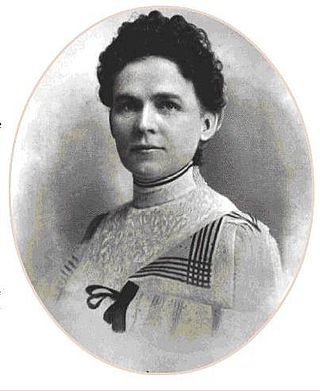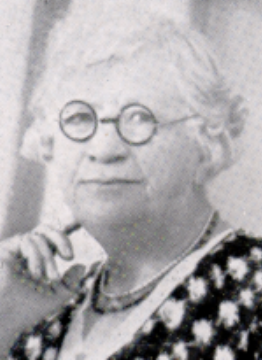
Jeannette Pickering Rankin was an American politician and women's rights advocate who became the first woman to hold federal office in the United States. She was elected to the U.S. House of Representatives as a Republican from Montana in 1916 for one term, then was elected again in 1940. Rankin remains the only woman ever elected to Congress from Montana.

Thomas James Walsh was an American lawyer and Democratic Party politician from Helena, Montana who represented Montana in the US Senate from 1913 to 1933. He was initially elected by the state legislature, and from 1918 on by popular vote, in keeping with the requirements of the Seventeenth Amendment to the United States Constitution.

Isabelle Case La Follette was a women's suffrage, peace, and civil rights activist in Wisconsin, United States. She worked with the Woman's Peace Party during World War I. At the time of her death in 1931, The New York Times called her "probably the least known yet most influential of all American women who have had to do with public affairs in this country." She was the wife and helpmate of Robert "Fighting Bob" La Follette—a prominent Progressive Republican politician both in Wisconsin and on the national scene—and as co-editor with her husband of La Follette's Weekly Magazine.

Ella Knowles Haskell was an American lawyer, suffragist, and politician. Born in New Hampshire, she moved to Montana to improve her health following a bout of tuberculosis and there became the first woman to be licensed as a lawyer, the first female notary public, the first woman to run for Montana State Attorney General, and the 26th woman to be admitted to practice before the US Supreme Court. She served as the President of the Montana Equal Suffrage Association and was widely known in Montana for her advancement of the suffrage movement, political feminism and social equity.
The Rankin Ranch is a historic ranch off Montana Highway 284, north of Townsend in rural Broadwater County, Montana. A National Historic Landmark, it was a longtime summer residence of Jeannette Rankin (1880-1973), whose 1916 election to the United States House of Representatives made her the first woman elected to the House. Her legacy includes a penchant for pacifism, women's rights, and social reform. She served another term from 1941 to 1943 when she was the only member of the House to oppose the declaration of war against Japan in 1941. A small portion of the ranch was designated a National Historic Landmark and listed on the National Register of Historic Places in 1976.

Ida Augusta Craft was an American suffragist known for her participation in suffrage hikes.

Nina Evans Allender was an American artist, cartoonist, and women's rights activist. She studied art in the United States and Europe with William Merritt Chase and Robert Henri. Allender worked as an organizer, speaker, and campaigner for women's suffrage and was the "official cartoonist" for the National Woman's Party's publications, creating what became known as the "Allender Girl."
This timeline highlights milestones in women's suffrage in the United States, particularly the right of women to vote in elections at federal and state levels.

Elsie Hill was an American suffragist, as were her sisters Clara and Helena Hill.
Kevin S. Giles is an American journalist and author whose books are set in his native western Montana. He was born and raised in western Montana. Two of his books take place in his hometown of Deer Lodge: a novel, "Summer of the Black Chevy" (2015) and the nonfiction work, "Jerry's Riot: The True Story of Montana's 1959 Prison Disturbance." (2005)

Barbara Steel ; 1857 – 22 December 1943) was a Scottish social activist who actively campaigned for Women's Suffrage in both the United Kingdom and South Africa. She was the first woman to stand in an election for the Edinburgh Town Council, when she ran in the 1907 election. Steel moved to South Africa in 1911 and at the beginning of World War I founded an organization to provide aid to South African soldiers and their families. She was honored as an Officer in the Order of the British Empire for her civil service. In addition, she served as president of the Women's Enfranchisement Association of the Union from 1916 until 1930, fighting for women's right to vote in South Africa.

Edna Bertha Rankin McKinnon was an American social activist for birth control. She was the executive director of the Chicago Planned Parenthood chapter.

This is a timeline of women's suffrage in Montana. The fight for women's suffrage in Montana started early, before Montana became a state. In 1887, women gained the right to vote in school board elections and on tax issues. In the years that followed, women battled for full, equal suffrage, which culminated in a year-long campaign in 1914 when they became one of eleven states with equal voting rights for most women. Montana ratified the Nineteenth Amendment on August 2, 1919 and was the thirteenth state to ratify. Native American women voters did not have equal rights to vote until 1924.

The women's suffrage movement in Montana started while it was still a territory. The Women's Christian Temperance Union (WCTU) was an early organizer that supported suffrage in the state, arriving in 1883. Women were given the right to vote in school board elections and on tax issues in 1887. When the state constitutional convention was held in 1889, Clara McAdow and Perry McAdow invited suffragist Henry Blackwell to speak to the delegates about equal women's suffrage. While that proposition did not pass, women retained their right to vote in school and tax elections as Montana became a state. In 1895, National American Woman Suffrage Association (NAWSA) came to Montana to organize local groups. Montana suffragists held a convention and created the Montana Woman's Suffrage Association (MWSA). Suffragists continued to organize, hold conventions and lobby the Montana Legislature for women's suffrage through the end of the nineteenth century. In the early twentieth century, Jeannette Rankin became a driving force around the women's suffrage movement in Montana. By January 1913, a women's suffrage bill had passed the Montana Legislature and went out as a referendum. Suffragists launched an all-out campaign leading up to the vote. They traveled throughout Montana giving speeches and holding rallies. They sent out thousands of letters and printed thousands of pamphlets and journals to hand out. Suffragists set up booths at the Montana State Fair and they held parades. Finally, after a somewhat contested election on November 3, 1914, the suffragists won the vote. Montana became one of eleven states with equal suffrage for most women. When the Nineteenth Amendment was passed, Montana ratified it on August 2, 1919. It wasn't until 1924 with the passage of the Indian Citizenship Act that Native American women gained the right to vote.
Martha Edgerton Rolfe Plassmann was a feminist and socialist from Montana, US.

Margaret Jane Steele Rozsa was an American government official in Butte, Montana who became the first female prohibition investigator for the United States in 1921. A longtime suffragist and women's rights advocate, she was also active in the women's club movement, serving as a member of the Good Government Club, Housewives League, Liberal Culture Club, and the Methodist Women's Missionary Society.

Minnie Reynolds Scalabrino was an American journalist, women's rights activist, and organizer, founding the Denver Women's Press Club and Denver Woman's Club. She advocated for equal rights, women's suffrage and temperance, something that she was devoted to for more than 30 years. She was instrumental in the passage of laws that gave women the right to vote at the state level, and then in 1920 for women throughout the United States.

As of 2022, Montana ranked 22nd out of 50 American states in terms of percentage of state legislators who are women. Within the Montana State Legislature, 32.7 percent of all members were women in 2022. From statehood in 1889 to 2021, the state of Montana had only one female governor, Judy Martz. Although the first woman to be elected to the United States Congress was from Montana in 1916, the state had not elected another woman to Congress as of 2021.














